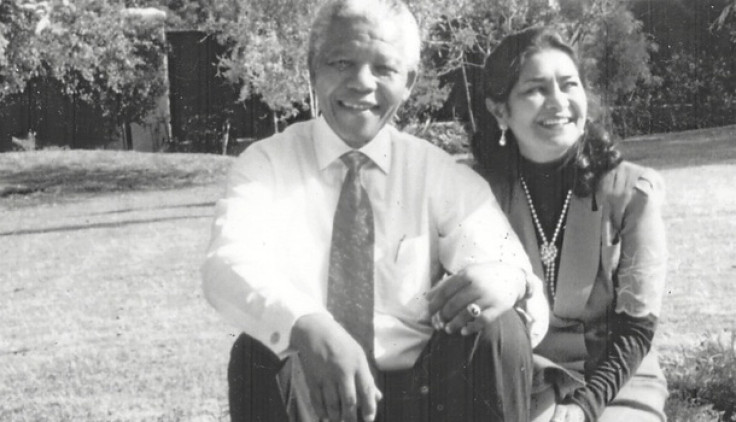Amina Cachalia: The Indian Woman Who May Have Been The Love of Nelson Mandela’s Life

Nelson Mandela, the 94-year-old anti-apartheid icon who lies in critical condition in a hospital in Pretoria, South Africa, once almost married an Indian woman – an act that would have given the nation’s 1.2 million Indians a first lady in government.
Mandela proposed marriage to Amina Cachalia – a longtime Indian anti-apartheid and women’s rights activist – soon after he divorced Winnie Madikizela-Mandela in 1996, according to various media reports as well as sections of Amina’s biography, “When Hope and History Rhyme,” which was released in February 2013, shortly after her death.
Amina, who was the widow of ANC activist Yusuf Cachalia – who had died in 1995 -- turned Mandela down, dismissing his declarations of love. A passage of her book details his attraction toward her and the intimate visits the two shared in each other’s homes and offices. “On one of these visits I must have been looking rather flustered as I bustled about doing my chores,” she wrote. “[Mandela] sat me down on the two-seater couch in the living room and kissed me passionately. Running his fingers through my hair he said: ‘Do you know that you are an exceptionally beautiful, vivacious and enticing young lady?’ I hollered at him. He looked very worried and wanted to know what was so wrong with what he had said. I replied gently: ‘I'm not a young lady; I am a middle-aged woman.’
“He looked relieved and said: ‘Okay let’s begin again.’ Then he repeated the string of adjectives, substituting 'old' for 'young' lady. I screamed again and said that I was not an old lady either,” she added.
Amina died in January 2013 at the age of 83. Her children, Ghaleb and Coco, confirmed the tale of Mandela’s proposal. “She called me and my sister aside and said she wanted to tell us about this proposal and that she was not going to accept it,” Ghaleb told the Guardian. “She was very matter of fact about it. We knew they were good friends, he was a friend of the family; he dropped in all the time. It didn't come as a surprise to us.”
In another section of her book, Amina described an uncomfortable evening when Mandela visited her in her flat in Johannesburg soon after he had married his third and current wife, Graca Machel. “That night Nelson declared his love for me in no uncertain terms,” Amina wrote. “I resisted, reminding him of his marriage, and the fact that while I may have been moved to consider his overtures positively, his marriage to Graca prevented me from doing so. I was free, he was not. He was clearly upset. I had hurt his feelings and resisted his advances. I begged with him to stay for crayfish but he brushed my pleas aside and walked out of the door.”
However, Amina visited Mandela in his home in the wealthy Johannesburg suburb of Houghton the very next day, claiming that Mandela said and wrote “beautiful, endearing things” to her. “The day before had evidently been forgotten and we were to make a fresh beginning,” Amina recalled. “But I told him that we were playing with fire and I prepared to tear up the [love] notes. He stopped me, assuring me that he would shred them once he had finished writing.”
She also noted that Mandela was “not a great romantic figure.” “Perhaps the years in prison had dampened that side of him,” she conjectured. “He would express his love or feelings in a rather matter-of-fact fashion. … But I could not return any of his rigid gestures of love. I was not in love with Nelson. I loved him dearly and yet I could not bring myself to want him as I did Yusuf, even in our old age.”
Yusuf Cachalia headed the Indian branch of the ANC for many years. His wife Amina came from a prominent family of South African Indian activists – her father Ebrahim Asvat was chairman of the Transvaal British Indian Association (later called the Transvaal Indian Congress) as well as a friend of Mahatma Gandhi during his early years in South Africa.
Mandela and Amina would not have been allowed to marry in South Africa during the years of apartheid. After the racist National Party was elected in 1948, one of the first pieces of legislation they passed, the Prohibition of Mixed Marriages Act of 1949, essentially banned marriage as well as sexual relations between people of different races – although it was primarily designed to prevent whites and nonwhites from mixing. That law was not repealed until 1985 under the presidency of P.W. Botha.
In addition, in post-apartheid South Africa, relations between the black African majority and the Indian minority remain tense, with periodic outbreaks of violence. Many South African blacks resent what they perceive to be the racist and discriminatory behavior of many Indians towards black people, as well as Indians’ apparent economic success in the country.
It remains unclear what impact Mandela’s marriage to an Indian woman would have on race relations in the country.
© Copyright IBTimes 2024. All rights reserved.











